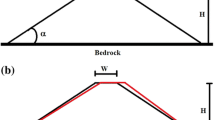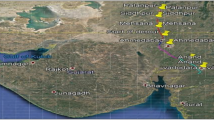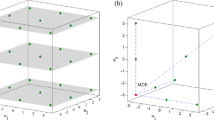Abstract
The use of probabilistic analysis of slopes as a useful technique for determining the level of uncertainty in various variables has grown. In this study, a probabilistic analysis of a representative embankment with a height of 12 m under seismic conditions was carried out utilizing the UPSS ADD-INs 3.0 and Subset Simulation methodologies. The seismic coefficients kh of 0.12, 0.14, and 0.18 were all taken into consideration. In order to account for uncertainty in soil properties including cohesiveness, angle of internal friction, and unit weight of soil, the study used lognormal random fields and Cholesky matrices. The use of Subset Simulation enabled the fast calculation of the reliability index and the probability of failure, providing significant insights into the embankment's failure risk. In addition, a hybrid computational technique was used to optimize the worst-case scenario for failure probability. To address a gap in the literature, this work focused on develo** a probabilistic analysis using subset simulation and a hybrid Artificial Neural Network-Teaching Learning-Based Optimization model. The performance of this model was evaluated and compared to existing hybrid models built using seven different swarm intelligence methods. During the validation phase, it was observed that the proposed Artificial Neural Network-Teaching Learning-Based Optimization model outperformed other hybrid models, exhibiting a high determination coefficient value of 0.9974 and a low root mean square error value of 0.0226. This superiority can be attributed to the Teaching Learning-Based Optimization component, which emphasizes global search by incorporating a teaching phase to improve less optimal solutions.












Similar content being viewed by others
Abbreviations
- SS:
-
Subset simulation
- Pf :
-
Probability of failure
- ANN:
-
Artificial neural network
- UPSS:
-
Uncertainty propagation using subset simulation
- FS:
-
Factor of safety
- β:
-
Reliability index
- LEM:
-
Limit equilibrium method
- SRM:
-
Strength reduction method
- LAM:
-
Limit analysis method
- FEM:
-
Finite element method
- FORM:
-
First-order reliability method
- FSM:
-
First-order second moment
- MCS:
-
Monte Carlo simulation
- RA:
-
Reliability analysis
- NN:
-
Neural network
- OA:
-
Optimization algorithm
- PSO:
-
Particle swarm optimization
- ABC:
-
Artificial bee colony
- ACO:
-
Ant colony optimization
- ALO:
-
Ant lion optimizer
- ICA:
-
Imperialist competitive algorithm
- TLBO:
-
Teaching–learning-based optimization
- DFCC:
-
Dedicated freight corridor
- MCMCS:
-
Markov chain Monte Carlo simulation
- GWO:
-
Grey wolf optimizer
- GA:
-
Genetic algorithm
- BBO:
-
Biography-based optimization
- ru :
-
Pore water pressure ratio
References
Baecher GB, Christian JT (2005) Reliability and statistics in geotechnical engineering. John Wiley & Sons, Hoboken
Fenton GA, Griffiths DV (2002) others, Probabilistic foundation settlement on spatially random soil. J Geotech Geoenviron Eng 128:381–390
Cheng YM, Lansivaara T, Wei WB (2007) Two-dimensional slope stability analysis by limit equilibrium and strength reduction methods. Comput Geotech 34:137–150
Reale C, Xue J, Pan Z, Gavin K (2015) Deterministic and probabilistic multi-modal analysis of slope stability. Comput Geotech 66:172–179. https://doi.org/10.1016/j.compgeo.2015.01.017
Chowdhury RN, Xu DW (1995) Geotechnical system reliability of slopes. Reliab Eng Syst Saf 47:141–151
Li D, Zhou C, Lu W, Jiang Q (2009) A system reliability approach for evaluating stability of rock wedges with correlated failure modes. Comput Geotech 36:1298–1307
Li D-Q, Jiang S-H, Chen Y-F, Zhou C-B (2011) System reliability analysis of rock slope stability involving correlated failure modes. KSCE J Civ Eng 15:1349–1359
Ang AH-S, Tang WH (1984) Probability concepts in engineering planning and design, vol. 2: Decision, risk, and reliability. John Wiley & Sons INC., Hoboken, pp. 1984, 608.
Phoon K-K (2008) Reliability-based design in geotechnical engineering: computations and applications. CRC Press, Florida
Sivakumar Babu GL, Mukesh MD (2004) Effect of soil variability on reliability of soil slopes. Geotechnique 54:335–337
Low BK, Tang WH (1997) Probabilistic slope analysis using Janbu’s generalized procedure of slices. Comput Geotech 21:121–142
Tang WH, Yucemen MS, Ang A-S (1976) Probability-based short term design of soil slopes. Can Geotech J 13:201–215
Christian JT, Ladd CC, Baecher GB (1994) Reliability applied to slope stability analysis. J Geotech Eng 120:2180–2207
Malkawi AIH, Hassan WF, Abdulla FA (2000) Uncertainty and reliability analysis applied to slope stability. Struct Saf 22:161–187
Cornell CA (1972) First-order uncertainty analysis of soil deformation and stability.
Hasofer AM, Lind NC (1974) Exact and invariant second-moment code format. J Eng Mech Div 100:111–121
Ditlevsen O (1981) Uncertainty modeling with applications to multidimensional civil engineering systems. McGraw-Hill International Book Company, New York.
Hammersley JM, Handscomb DC (1964) percolation processes In: Monte Carlo methods. Springer, pp 134–141.
Robert CP, Casella G, Casella G (1999) Monte Carlo statistical methods. Springer.
Low BK (2003) Practical probabilistic slope stability analysis. Proc Soil Rock Am 12:22–26
El-Ramly H, Morgenstern NR, Cruden DM (2002) Probabilistic slope stability analysis for practice. Can Geotech J 39:665–683
Wang Y, Cao Z, Au S-K (2011) Practical reliability analysis of slope stability by advanced Monte Carlo simulations in a spreadsheet. Can Geotech J 48:162–172
Cao Z, Wang Y, Li D (2017) Probabilistic approaches for geotechnical site characterization and slope stability analysis. Springer.
Hammersley JM, Handscomb DC (1964) The general nature of Monte Carlo methods In: Monte Carlo Methods. Springer, pp 1–9
Fishman GS (1996) Random tours. Monte Carlo, pp. 335–491.
Engelund S, Rackwitz R (1993) A benchmark study on importance sampling techniques in structural reliability. Struct Saf 12:255–276
Schuëller GI, Pradlwarter HJ (2007) Benchmark study on reliability estimation in higher dimensions of structural systems—an overview. Struct Saf 29:167–182
Melchers RE, Beck AT (2018) Structural reliability analysis and prediction. John wiley & sons, Hoboken
Low BK, Tang WH (1997) Efficient reliability evaluation using spreadsheet. J Eng Mech 123:749–752
Low BK, Tang WH (2004) Reliability analysis using object-oriented constrained optimization. Struct Saf 26:69–89
Low BK, Tang WH (2007) Efficient spreadsheet algorithm for first-order reliability method. J Eng Mech 133:1378–1387
Au S-K, Beck JL (2001) Estimation of small failure probabilities in high dimensions by subset simulation. Prob Eng Mech 16:263–277
Au SK, Ching J, Beck JL (2007) Application of subset simulation methods to reliability benchmark problems. Struct Saf 29:183–193. https://doi.org/10.1016/j.strusafe.2006.07.008
Shariati M, Armaghani DJ, Khandelwal M, Zhou J, Khorami M (2021) Assessment of longstanding effects of fly ash and silica fume on the compressive strength of concrete using extreme learning machine and artificial neural network. J Adv Eng Comput 5:50–74
Shariati M, Mafipour MS, Mehrabi P, Shariati A, Toghroli A, Trung NT, Salih MNA (2021) A novel approach to predict shear strength of tilted angle connectors using artificial intelligence techniques. Eng Comput 37:2089–2109
Deng J, Gu D, Li X, Yue ZQ (2005) Structural reliability analysis for implicit performance functions using artificial neural network. Struct Saf 27:25–48
Deng J (2006) Structural reliability analysis for implicit performance function using radial basis function network. Int J Solids Struct 43:3255–3291
Cho SE (2009) Probabilistic stability analyses of slopes using the ANN-based response surface. Comput Geotech 36:787–797
Erzin Y, Cetin T (2012) The use of neural networks for the prediction of the critical factor of safety of an artificial slope subjected to earthquake forces. Sci Iran 19:188–194
Zhao H (2008) Slope reliability analysis using a support vector machine. Comput Geotech 35:459–467
Kang F, Xu Q, Li J (2016) Slope reliability analysis using surrogate models via new support vector machines with swarm intelligence. Appl Math Model 40:6105–6120. https://doi.org/10.1016/j.apm.2016.01.050
Kumar V, Samui P, Himanshu N, Burman A (2019) Reliability-based slope stability analysis of durgawati earthen dam considering steady and transient state seepage conditions using MARS and RVM. Indian Geotech J 49:650–666. https://doi.org/10.1007/s40098-019-00373-7
Li S, Zhao H, Ru Z (2017) Relevance vector machine-based response surface for slope reliability analysis. Int J Numer Anal Methods Geomech 41:1332–1346
Yang J, Cheng L, Ran L (2021) Research on slope reliability analysis using multi-kernel relevance vector machine and advanced first-order second-moment method. Eng Comput 23:1–12
Samui P, Lansivaara T, Bhatt MR (2013) Least square support vector machine applied to slope reliability analysis. Geotech Geol Eng 31:1329–1334
He X, Xu H, Sabetamal H, Sheng D (2020) Machine learning aided stochastic reliability analysis of spatially variable slopes. Comput Geotech 126:103711
Bardhan A, Samui P (2022) Probabilistic slope stability analysis of Heavy-haul freight corridor using a hybrid machine learning paradigm. Transp Geotech 37:100815. https://doi.org/10.1016/j.trgeo.2022.100815
Bardhan A, Manna P, Kumar V, Burman A, Žlender B, Samui P (2021) Reliability analysis of piled raft foundation using a novel hybrid approach of ann and equilibrium optimizer. Comput Model Eng Sci 128:15885. https://doi.org/10.32604/cmes.2021.015885
Liou S-W, Wang C-M, Huang Y-F (2009) Integrative discovery of multifaceted sequence patterns by frame-relayed search and hybrid PSO-ANN. J UCS 15:742–764
Koopialipoor M, Fallah A, Armaghani DJ, Azizi A, Mohamad ET (2019) Three hybrid intelligent models in estimating flyrock distance resulting from blasting. Eng Comput 35:243–256. https://doi.org/10.1007/s00366-018-0596-4
Golafshani EM, Behnood A, Arashpour M (2020) Predicting the compressive strength of normal and high-performance concretes using ANN and ANFIS hybridized with grey wolf optimizer. Constr Build Mater 232:117266. https://doi.org/10.1016/j.conbuildmat.2019.117266
Le LT, Nguyen H, Dou J, Zhou J (2019) A comparative study of PSO-ANN, GA-ANN, ICA-ANN, and ABC-ANN in estimating the heating load of buildings’ energy efficiency for smart city planning. Appl Sci 9:2630
Armaghani DJ, Mirzaei F, Shariati M, Trung NT, Shariati M, Trnavac D (2020) Hybrid ANN-based techniques in predicting cohesion of sandy-soil combined with fiber. Geomech Eng 20:191–205
Shariati M, Mafipour MS, Mehrabi P, Ahmadi M, Wakil K, Trung NT, Toghroli A (2020) Prediction of concrete strength in presence of furnace slag and fly ash using Hybrid ANN-GA (Artificial neural network-genetic algorithm). Smart Struct Syst Int J 25:183–195
Shariati M, Mafipour MS, Mehrabi P, Bahadori A, Zandi Y, Salih MNA, Nguyen H, Dou J, Song X, Poi-Ngian S (2019) Application of a hybrid artificial neural network-particle swarm optimization (ANN-PSO) model in behavior prediction of channel shear connectors embedded in normal and high-strength concrete. Appl Sci 9:5534
Bishop AW (1955) The use of the slip circle in the stability analysis of slopes. Géotechnique 5:7–17. https://doi.org/10.1680/geot.1955.5.1.7
RDSO/2007/GE:0014 (2009) Guidelines and specifications for design of formation for heavy axle load. Research Designs and Standards Organisation, Lucknow.
RDSO/GE:IRS-0004 (2020) Comprehensive guidelines and specifications for railway formation. Research Designs and Standards Organisation, Lucknow.
RDSO/2003/GE:G-1 (2003) Guidelines for earthwork in railway projects. Research Designs and Standards Organisation.
IRC (2015) 75–2015, Guidelines for the design of high embankments, Indian Road Congress.
Sabri MS, Ahmad F, Samui P (2023) Slope stability analysis of heavy-haul freight corridor using novel machine learning approach. Model Earth Syst Environ 23:1–19
Vanmarcke EH (1977) Probabilistic modeling of soil profiles. J Geotech Eng Div 103:1227–1246
Fenton GA, Griffiths DV (2008) Risk assessment in geotechnical engineering. John Wiley & Sons, New York
Li D-Q, **ao T, Cao Z-J, Zhou C-B, Zhang L-M (2016) Enhancement of random finite element method in reliability analysis and risk assessment of soil slopes using subset simulation. Landslides 13:293–303
Zhu B, Hiraishi T, Pei H, Yang Q (2021) Efficient reliability analysis of slopes integrating the random field method and a Gaussian process regression-based surrogate model. Int J Numer Anal Methods Geomech 45:478–501
Au S-K, Wang Y (2014) Engineering risk assessment with subset simulation. John Wiley & Sons, Hoboken
Wang Y, Cao Z (2013) Expanded reliability-based design of piles in spatially variable soil using efficient Monte Carlo simulations. Soils Found 53:820–834
Kadam AK, Wagh VM, Muley AA, Umrikar BN, Sankhua RN (2019) Prediction of water quality index using artificial neural network and multiple linear regression modelling approach in Shivganga River basin, India. Model Earth Syst Environ 5:951–962
Sarigöl M, Yesilyurt SN (2022) Flood routing calculation with ANN, SVM, GPR, and RTE methods. Pol J Env Stud 31:1–8
Dalkiliç HY, Hashimi SA (2020) Prediction of daily streamflow using artificial neural networks (ANNs), wavelet neural networks (WNNs), and adaptive neuro-fuzzy inference system (ANFIS) models. Water Supply 20:1396–1408
Ojha VK, Abraham A, Snášel V (2017) Metaheuristic design of feedforward neural networks: a review of two decades of research. Eng Appl Artif Intell 60:97–116
Lumb P (1974) Application of statistics in soil mechanics. Soil Mech New Horiz 56:44–111
Singh A (1972) How reliable is the factor of safety in foundation engineering?. A conference paper
Harr ME (1984) Reliability-based design in civil engineering. Department of Civil Engineering School of Engineering, North Carolina State
Kulhawy FH (1992) On the evaluation of soil properties. In: Kulhawy FH (ed) ASCE geotechnology. Special Publication, London, pp 95–1153
Kar SS, Roy LB (2021) Reliability analysis of a finite slope considering the effects of soil uncertainty. Int J Perform Eng 17:473–483. https://doi.org/10.23940/ijpe.21.05.p7.473483
Au SK, Cao ZJ, Wang Y (2010) Implementing advanced Monte Carlo simulation under spreadsheet environment. Struct Saf 32:281–292
Behar O, Khellaf A, Mohammedi K (2015) Comparison of solar radiation models and their validation under Algerian climate—The case of direct irradiance. Energy Convers Manag 98:236–251
Legates DR, McCabe GJ (2013) A refined index of model performance: a rejoinder. Int J Climatol 33:1053–1056
Willmott CJ (1984) On the evaluation of model performance in physical geography In: Spatial and statistic model. Springer, pp 443–460.
Wong FS (1985) Slope reliability and response surface method. J Geotech Eng 111:32–53
Chai T, Draxler RR (2014) Root mean square error (RMSE) or mean absolute error (MAE)?–Arguments against avoiding RMSE in the literature. Geosci Model Dev 7:1247–1250
Stone RJ (1993) Improved statistical procedure for the evaluation of solar radiation estimation models. Sol Energy 51:289–291
Kardani N, Aminpour M, Raja MNA, Kumar G, Bardhan A, Nazem M (2022) Prediction of the resilient modulus of compacted subgrade soils using ensemble machine learning methods. Transp Geotech 36:100827
Acknowledgements
Profs. Siu-Kui Au (University of Liverpool, UK), Yu Wang (City University of Hong Kong, China), and Zijun Cao (Wuhan University, China) are thanked for making available the MS-Excel Add-In UPSS module used in this study.
Funding
There has been no external funding.
Author information
Authors and Affiliations
Contributions
F.A. contributed to methodology, materials, programs, validation, graphics, first draft, review & editing writing; P.S. contributed to guidance. S.S.M. contributed to guidance.
Corresponding author
Ethics declarations
Conflict of interest
The authors declare that they have no conflict of interest.
Additional information
Publisher's Note
Springer Nature remains neutral with regard to jurisdictional claims in published maps and institutional affiliations.
Rights and permissions
Springer Nature or its licensor (e.g. a society or other partner) holds exclusive rights to this article under a publishing agreement with the author(s) or other rightsholder(s); author self-archiving of the accepted manuscript version of this article is solely governed by the terms of such publishing agreement and applicable law.
About this article
Cite this article
Ahmad, F., Samui, P. & Mishra, S.S. Probabilistic Analysis of Slope Using Bishop Method of Slices with the Help of Subset Simulation Subsequently Aided with Hybrid Machine Learning Paradigm. Indian Geotech J 54, 577–597 (2024). https://doi.org/10.1007/s40098-023-00796-3
Received:
Accepted:
Published:
Issue Date:
DOI: https://doi.org/10.1007/s40098-023-00796-3




